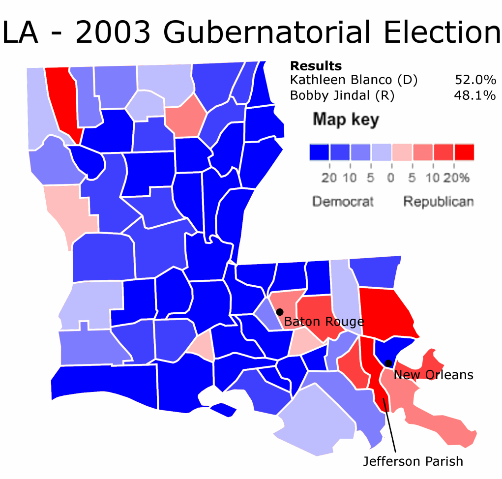By: Inoljt, http://mypolitikal.com/
This is the first part of two posts analyzing Louisiana’s 2003 gubernatorial election, in which Republican candidate Bobby Jindal narrowly lost to lieutenant governor Kathleen Blanco. The second part can be found here.
Bobby Jindal’s Strange Coalition
In 2003, an ambitious Bobby Jindal ran for Louisiana governor against Democratic candidate Kathleen Blanco. Despite holding a narrow polling lead throughout most of the campaign, Mr. Jindal ended up losing by a three-point margin.
The story of the coalition that voted for Mr. Jindal constitutes quite the interesting tale. It is much different from the Republican base as commonly envisioned in the Deep South.
To begin, let’s take a look at a map of the election – which is substantially different from most modern electoral maps. Here it is:
More below.
The first thing that strikes the eye is the sheer number of parishes Mr. Jindal lost. He was absolutely crushed in rural Louisiana.
This is a remarkable thing. In the United States of today, it is usually an accomplishment for a Democrat to win a state’s rural counties, even in a landslide. Democrats almost never win the rural vote when the election is close.
Mr. Jindal, of course, got 48% of the vote somewhere. As it turns out, these votes came mainly from the state’s most populous parishes. The state’s most populous parish – Jefferson Parish – voted for Mr. Jindal by more than a 3-to-2 margin. In New Orleans, with the endorsement of Mayor Ray Nagin, Mr. Jindal did as well as possible for a Republican, winning almost one-third of the vote.
In other words, Mr. Jindal used strong margins from metropolitan, suburban Louisiana to counter Ms. Blanco’s rural strength and New Orleans – a strategy more familiar to Democrats than Republicans.
Here is a more “normal” election in Louisiana:
Although it does not look like it, Republican candidate Suzanne Terrell did only one point better than Mr. Jindal.
There are substantial differences in their coalitions, however. Ms. Terrell did worse in the populous southeast, although the map does not show it well. She lost Baton Rouge (which Mr. Jindal won) and took only one-fifth of the vote in New Orleans, compared to the one-third Mr. Jindall racked up.
On the other hand, Ms. Terrell performed far better in rural, northern Louisiana – winning a number of thinly populated, poor parishes that Mr. Jindal lost. It was Mr. Jindal’s performance that constituted the aberration; deeply conservative, these parishes are a core part of the Republican base.
The next section will focus on the racial dynamics that caused this effect.


Shows how far the South has come in just a few years. If the race had gone all the same and Jindal had been a white guy, Jindal would be in the middle of his second term as governor now. In just 4 years though, those same voters were comfortable with his race and voted for him overwhelmingly. This dynamic of the South being more comfortable with non-whites is showing in SC too.
among black voters, despite his economic conservatism. That’s why Landrieu won by performing better in Caddo and Baton Rouge, plus she always gets truly gargantuan margins in New Orleans and does much better in Jefferson than Democrats normally do. She won in 2008 by actually winning Jefferson Parish, while getting big margins in major parishes such as Caddo and East Baton Rouge. She also did about as well as a Democrat can in st. Tammany Parish, (40%).